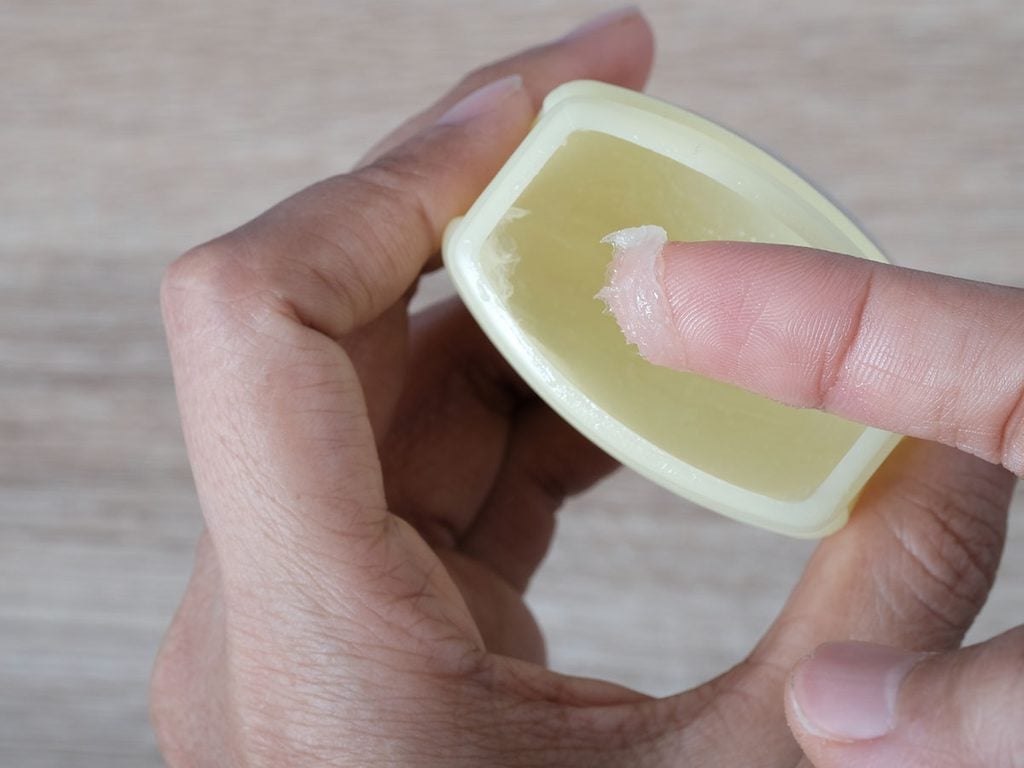The Truth About Petrolatum: Does It Belong in Your Skin Care Products?

Petrolatum cuts a wide swath in skin care. Why are many companies choosing not to use it?
When my two toddlers had itchy rashes on their chests, my doctor diagnosed eczema. The cure: no more bubble baths, and plenty of thick, perfume-free moisturizer. “The best thing you can use is good old Vaseline,” she said.
Doctors like mine have been recommending petroleum jelly (also called petrolatum) for more than 100 years. In the 1850s, chemist Robert Chesebrough started the process of distilling and cleaning the thick gel found on oil wells. By 1870, Vaseline was being sold in the United States.
In industry, petrolatum acts as a lubricant for machinery. Today, we also use it to relieve diaper rash, heal raw noses and soothe chapped lips. (Some people also use it as a sexual lubricant, but it weakens latex condoms.) It’s also an ingredient in a variety of moisturizing products. The Environmental Working Group (EWG), a U.S. non-profit organization that does environmental and safety studies, says there’s petrolatum in one out of every 14 cosmetic products on the market, including 15 percent of lipsticks and 40 percent of baby lotions and oils. Plus, it’s used as an active ingredient for healing cuts and burns.
So why are a host of new cosmetic products—many of them organic or natural—promoting themselves as “petrolatum free”? It raises a host of questions: Is petrolatum safe? Should we only be buying products that are petrolatum-free?
Is petrolatum safe?
Health Canada considers petrolatum non-toxic. As for the Canadian Cosmetic, Toiletry and Fragrance Association (CCTFA), a trade organization that consults with the government on ingredients, its stand is that “it’s pretty much as universally safe as any substance could possibly be,” says spokesperson Mike Patton. However, the EWG gives it a “moderate hazard” safety rating and says cosmetics that use petrolatum need more study for safety.
Why? The EWG says—and governments and the CCTFA acknowledge—there is a risk of contamination from polycyclic aromatic hydrocarbons (PAHs), cancer-causing chemicals found in crude oil and its by-products. While no studies have ever shown a direct link between petrolatum and cancer, the European Union put numerous grades of petrolatum on a list of dangerous substances. Only highly refined petrolatum can be used in cosmetics there. It’s for these reasons that the David Suzuki Foundation includes petrolatum on its Dirty Dozen list of cosmetic ingredients. But how much do you need to worry?
Petrolatum use in Canada
Petrolatum used in cosmetic and personal care products sold in Canada is also a highly refined grade and must meet all of the standards set by the United States Pharmacopeia (USP), including limits for PAHs. Petrolatum used as an active ingredient in over-the-counter drugs goes through even stricter regulatory control.
Is there a chance toxins could be missed during processing and testing? Companies that produce petrolatum products say no. “Our personal care products are tested and meet all of the safety and regulatory requirements as set by Health Canada,” says Paul Hughes, technical manager for Unilever Canada, maker of Vaseline. “Some people are creating fear among consumers by telling only part of the story.”
Does petrolatum heal skin?
While some beauty companies are promoting petrolatum alternatives, other manufacturers swear by its ability to moisturize and heal. Petrolatum seals off the skin from water and air, and “it allows the skin to heal itself,” says Calgary pharmacist Skip Gibson. He’s vice-president of sales and marketing for George’s Special Dry Skin Cream, a petroleum jelly-based cream that he helped create.
“Petroleum jelly is the most effective moisturizer available,” says Vancouver dermatologist Dr. Richard Thomas. “The reduction in water loss makes it easier for the epidermis to continue normal function.”
Dr. Sandy Skotnicki, a Toronto-based dermatologist and skin allergy expert agrees with the efficacy of petroleum jelly. In her 2018 book, Beyond Soap, she writes: “I’ve seen studies that demonstrate the effectiveness of everything from plain old Vaseline to sunflower oil.” She includes a list of recommended moisturizers for babies and children, which includes, in addition to Vaseline Petroleum Jelly and sunflower oil, suggestions like Aveeno Baby Eczema Therapy Moisturizing Cream, CeraVe Moisturizing Cream, and more.
But there is a potential downside to the effectiveness of petroleum jelly. A study that was published in Pediatrics in 2000 found that extremely-low-birth-weight infants treated with petroleum jelly were more likely to develop systemic candidiasis; it created a warm, moist place for fungi to grow. “Sometimes you want the skin to breathe more,” says Celeste Lutrario, vice president of research and development for Burt’s Bees, which does not use petrolatum in its products. She says petrolatum is an occlusive barrier, locking in moisture—but it does not allow moisture to be absorbed from the atmosphere. For example, lip balms with petrolatum and other petrochemicals can be less moisturizing than those with emollients that enable moisture exchange, contends Lutrario.
Is there an environmental impact?
Petrolatum comes from crude oil, and as such is not a renewable resource. Of course, the volume of the ingredients in one jar of petroleum jelly or a bottle of body moisturizer doesn’t come close to that used to fuel cars or run factories. Still, Health Canada is still investigating the environmental impact of petrolatum in cosmetics.
Concern for our planet and its resources is another reason why some companies are using oils from coconuts, sunflowers and olives in the formulation of their products. But these oils have an environmental footprint, too: They come from farmland, potentially displacing food crops.
Alternatives to petrolatum in cosmetics are more expensive and trickier to formulate. Right now, petrolatum is cheap, plentiful and generally safe, and it mixes up easily in the lab to create the products we use every day—it’s not going anywhere soon.
Next: Why You Might Want to Stop Using Beauty Products With Talc




